Australian economy pushes its luck
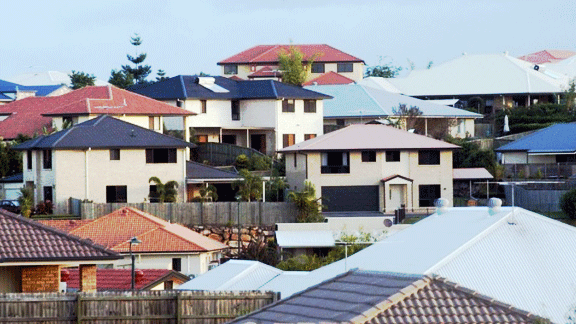
Australia’s 23-year economic expansion is unprecedented for a developed country. In the 21st century, growth has been underpinned by property and mining investment booms. The latter is now over, the former reaching its limits.
The property boom has been based on the accumulation of debt. Before the long expansion began in 1991, the average household debt-to-income ratio was less than 50 percent. Today it is more than 150 percent.

Property prices have been driven up on one hand by an expansion of credit and then low interest rates, on the other by government subsidies in the form of home buyer grants, negative gearing and the halving of capital gains tax in the late 1990s.
The price rises in turn resulted in an explosion of construction, both commercial and residential. Corporate profits in the construction and rental and real estate service industries increased nine-fold between 2000 and 2014.
The mining boom resulted from China’s fast economic growth. Rapidly increasing resources prices drove a quadrupling of mining investment in 2005-12. Chinese companies were buying iron ore and coal at prices well above the costs of production and well above their long run price. The mining companies’ super profits were based on wealth transfers from China much greater than when resources prices haven’t been booming.
On several occasions, mining profits reached 40 percent or more of total corporate profits, despite the industry employing just 2 percent of the workforce and accounting for less than 10 percent of economic output. The result was that gross domestic income (the purchasing power of the total economy) rose much faster than gross domestic product (what the total economy was producing).
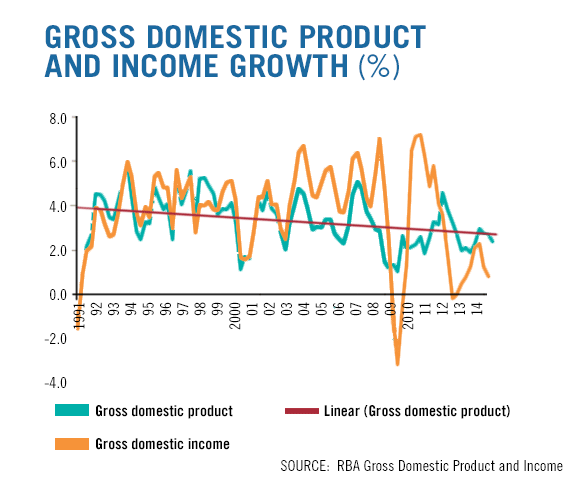
The proceeds were distributed unevenly. Mining companies and their owners took the lion’s share, but the boom also had an impact on the rest of the economy. There was rapid growth in industries directly servicing mining: professional, scientific and technical services, and transport and logistics, for example.
Some of the value was redistributed through government spending and tax cuts, which were sustained by rising state royalties and federal tax revenues. A smaller amount was transferred through the stock market, via the high wages of mining workers and via infrastructure development.
A 2014 Reserve Bank research paper estimated that the mining expansion, over the course of a decade, increased real per capita household disposable income by 13 percent. In effect, the economy received a boost from overseas resource importers, without increasing its output commensurately.
At the same time, the property boom (which was supplemented by this wash from the mining industry) generated its own “wealth effect”. The banks borrowed on international markets in order to offer larger mortgages. With few exceptions, those who took on debt watched the price of their asset climb further. The result was an increase in spending because property owners thought they were wealthier.
In the years prior to the financial crisis, annual housing and business credit growth both peaked at more than 20 percent. The banks were raking it in. Retail and supplier businesses were beneficiaries, both of the increase in total income and the spending driven by rising asset prices. Wholesale trade profits have quadrupled, and in retail they have grown five-fold since the early 2000s.
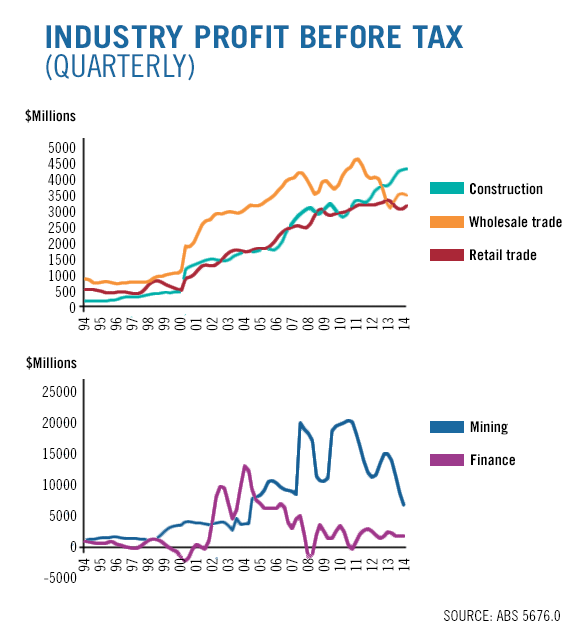
There have of course been casualties. Exporters have faced headwinds in the form of a high Australian dollar and higher borrowing rates than many countries. Local production for the Australian market, especially manufacturing, has suffered an accelerated decline.
Limits of the boom
The mining investment boom is over. There is now a gaping hole in business investment – the most important driver of economic growth. The latest figures indicate that capital expenditures are up in some areas of the economy, including manufacturing. But there are several things to note.
First, overall, investment levels are low, nothing to match the mining investment hole.
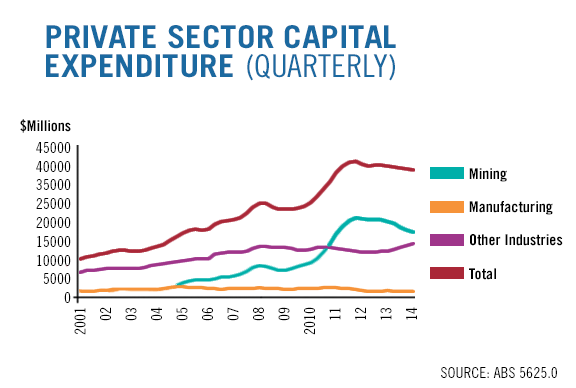
Second, the investment growth is led by retail trade, residential construction and real estate services – all of which are dependent in some way on the housing price boom continuing, or at least not collapsing. All are also exposed to the collapse in commodity prices – national income growth is stalling. On a per capita basis, it is falling. That is slowing the economy.
Third, projections for future investment are bleak. Jacob Greber, writing in the Financial Review on 27 February, noted: “Estimates for 2015-16 showed mining companies will cut spending by 20 percent, manufacturers by 20 percent and the rest of business by another 7 percent.”
Property is still booming, in part due to low interest rates. But price growth has been concentrated in Sydney and Melbourne. It doesn’t seem to have the same broad base it once did. That limits the wealth effect. Extravagant levels of household debt, combined with sluggish wage growth and the highest unemployment rate in 12 years, place limits on how long the market can keep bubbling, even with an influx of overseas buyers.
Fourth, housing loans are distributed in a way that makes large numbers of people vulnerable to a price slump. According to Australian Securities Exchange estimates, more than one-quarter of the adult population owns an investment property. Proportionally, the rich have the highest number. But a significant proportion of “middle Australia”, if we define that as households with an income above the bottom 40 percent but below the top 20 percent, has jumped onto the property train. Reserve bank figures show that more than 40 percent of these households have a home mortgage and one in 10 holds investment property debt. (Keep in mind that household debts and investments often are held by more than one member of a household).

These households are arguably the most exposed to an economic downturn and probably are the weakest link in the housing boom’s chain. The wages component of their incomes is higher than the richest households, which get a substantial amount from profits, interest, rent and share dividends and have greater financial resources to draw on. And the poorest households on average have much lower levels of debt. (Of the bottom 20 percent of households, only 12 percent have mortgage debt and 3 percent investment property debt.)
So one boom is over and the other is butting against its limits – and the knock-on effects they had on the rest of the economy also are reaching their limits. Gross national income is now growing more slowly than gross domestic product.
Importantly, with the winding down of mining investment, the downward revisions to government revenue forecasts, which are hammering the budget, have continued. Labor treasurer Wayne Swan’s final budget in 2013 noted that “tax receipts … have been revised down by around $60 billion over the four years to 2015-16 since” the mid-year outlook, released six months earlier. That came on top of $170 billion of downward revisions over the previous five years. Since the Liberals took office, Treasury has written down tens of billions of dollars more. Without increasing taxation or borrowing, the government has less money to play with.
The innovation agenda
Big and small business alike want attacks on workers. Getting rid of penalty rates, gutting awards and making individual contracts more central to employment agreements – all are being argued for.
However, the rate of business investment is determined not simply by wage levels, but by expected return on the total investment. That is shaped not only by domestic factors, but also by the international economic situation. And the outlook for the world economy is still not good.
As the Financial Review editorial noted on 28 February: “One reason why business spirits are so subdued is that the printing of trillions of dollars by central banks around the world has not had all the effect that was hoped for in stimulating demand and investment. Even the best-performing economies are patchy [and] many are stagnating.”
Instead, money continues to flow into stocks, bonds and, in Australia, property.
The need for productivity growth – the efficiency with which production inputs are turned into outputs – is raised repeatedly in government and business white papers and policy documents. Companies that are first with productivity-enhancing innovation are able to do what the mining industry achieved by virtue of high prices: get extra profits, which represent a greater transfer of wealth from their customers at the expense of their competitors, until most of the industry adopts the innovations. Industries and countries that do this best can increase their market and profit shares and expand in relation to their competitors. Those that don’t are left behind. That’s true in times of boom and stagnation.
Most of the business and political establishment are concerned to increase productivity so that Australian industries become world beaters. The simplest measure of this is labour productivity, the amount of output per hour of labour. This has increased decade after decade and continues to increase, albeit more slowly than in the past. Workers are doing the heavy lifting for the capitalist economy.
But another measure, termed multifactor productivity, has been sluggish or in reverse over the last decade. Multifactor productivity takes into account not simply output per hour, but the cost of the output-increasing investments. As Reserve Bank economists Patrick D'Arcy and Linus Gustafsson put it: “For investment to drive gains in multifactor productivity there need to be ‘spillover’ effects that generate a more than commensurate increase in output than the increase in capital.
“In practice, this typically requires the introduction of a new technology to be associated with some fundamental reorganisation of production processes, or the development of a genuinely new technology that has benefits greater than the research costs required to develop it.”
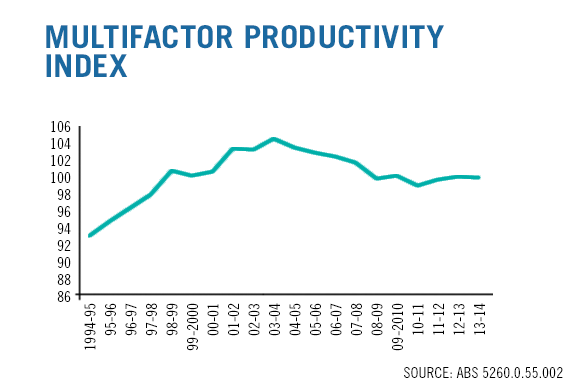
The Australian ruling class is worried about the slow pace of this technological progress in industry. Less than 6 percent of Australian firms develop genuinely new technologies to improve performance (compared with more than 20 percent in Germany, for example).
The Department of Industry noted last year in a consultation session on its “industry growth centres” initiative: “Australia ranks … 23 out of 26 OECD countries for businesses collaborating on innovation; last out of 30 OECD nations for business–research collaborations; 81 out of 143 countries on how effectively we get returns from research.”
Australian capitalism is drifting behind its international competitors. A Reserve Bank discussion paper last August warned that, compared with three decades ago, more production now occurs “towards the start of the supply chain”, i.e. in lower value-added assembly-type work as opposed to high tech, high productivity manufacture.
Part of the solution, in the eyes of business, is greater commercialisation of research, i.e. further subordination of scientific research to industry and the drive for profit. That may go some way to explaining why the government is doggedly pursuing deregulation of the university system. Another part is larger handouts from government in the form of tax breaks for firms engaged in research and development.
The problem for the capitalists, however, is that even when capital investment was high, technological innovation was exceptional or non-existent and the rate of GDP growth was declining. Now, investment is also projected to fall.
The economy is undergoing transitions, internally and in relation to the rest of the world, but what exactly it is transitioning to is far from clear. The only thing that appears certain is that life is set to get harder.
Businesses are reluctant to invest because they don’t envisage great returns. The Reserve Bank not only has little capacity to increase business spending; it has, through cheap money, contributed to asset price bubbles. Private debt apparently has plateaued, wages are flat and unemployment is rising, leaving little room for consumer-led expansion. And both the ALP and the Liberals are committed to preserving the entitlements of the rich, leaving little room for more spending in the federal budget.